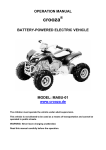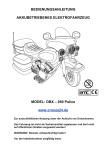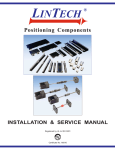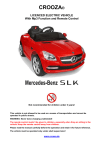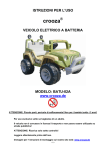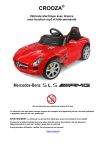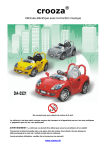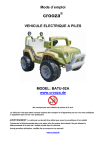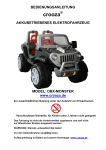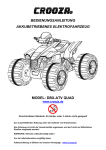Download Crooza DBX - 4x4 Operating instructions
Transcript
OPERATION MANUAL BATTERY-POWERED ELECTRIC VEHICLE MODEL: DBX - 4x4 OFF-ROADER www.crooza.de The vehicle must be operated only under adult supervision. This vehicle is not allowed to be used as a means of transportation and mustn’t be operated in public streets. WARNING: Never leave charging unattended! Read this manual carefully before the operation. ELECTRIC SHOCK WARNING • Unfixed batteries may fall off the overturned vehicle and cause injuries. Ensure that the batteries have been fixed carefully. • FIRE PREVENTION - The electric system of the vehicle is not allowed to be altered. Alterations may lead to fire, black-out of the electric systems and serious injuries. - Using wrong batteries and chargers may lead to fire, explosion and serious injuries. - Only adults are allowed to handle batteries. The batteries, which are quite heavy, are filled with electrolyte. Leaking batteries may lead to serious injuries. - Do not let your children to charge the batteries. Only adults are allowed to charge the batteries. Children may get injured by an electric shock. - Please check the batteries, cable connections and the connector of the charger before charging the batteries. If you find any defects, do not charge them until they are repaired by an expert. - The motors produce HEAT! Be careful during the contact with the motors. SAFE DRIVING WARNING PREVENTING INJURIES • The vehicle must be operated only under adult supervision! • Never use the vehicle in darkness! • Operation only on safe grounds! E.g: In areas - without swimming pools or ponds. Risk of drowning! - without slopes. - far from stairs, ramps, slopes, streets and boulevards. • Operating Directives Ensure that the following rules are followed for a safe operation: - Always sitting properly on the seat. - No driving without sturdy shoes. NOTICE • Small items are included in the package at delivery status. Assembling must be conducted under adult supervision. Children may swallow the small items. Risk of choking. -1- WARNING The charger must be used only in a dry environment. - If the fuse blows out, it must be replaced with a charger having the same quality. In order to avoid repeated operational disruptions, ensure that the vehicle doesn’t carry more than 50 kg. Avoid unfavorable conditions such as slopes or solid objects like walls. Otherwise, the wheels may stand still and the motors may get overcharged. Teach your child to keep the vehicle still before changing the direction. - If the fuse doesn’t comply with the normal operational conditions, contact your service. - Before the first operation, the batteries must be charged at least 8-10 hours once. - The charging time mustn’t exceed 15 hours once. - While being charged, the batteries must stand vertical. - The charger is not a toy and not suitable for children. - The batteries mustn’t be short-circuited. - Charging through contaminated socket can lead to short-circuit and other defects. Therefore, it must be refrained. - The charging process must be carried out safely, FAR from easily inflammable materials. Look out excessive smoke and heat generation. - The charging process must be conducted continuously under adult supervision! Never leave the vehicle unattended while being charged. If you park it, turn off the main switch. SECURITY CHECK BEFORE THE FIRST OPERATION Pay attention to unusual sounds like loose parts or broken components during the operation. If you are unsure, please consult an experienced mechanic. ! THIS OPERATION MANUAL CONTAINS IMPORTANT INSTRUCTIONS FOR A SAFE OPERATION OF THE VEHİCLE. IMPORTANT MESSAGE FOR PARENTS: READ THE WHOLE MANUAL CAREFULLY BEFORE OPERATING THE VEHICLE AND FOLLOW THE INSTRUCTIONS. The guarantee for a safe operation lies behind the parents’ responsibility. Parents must ensure that they have read all the warnings and security instructions, which will be then explained to children so as to follow. Parents are also responsible for whether the child is ready mentally and physically to operate the vehicle according to the conditions. It is recommended to go through the operating instructions periodically together with the young drivers and to examine the vehicle for possible defects and to carry out the regular maintenances. Whether a child is ready to operate this vehicle depends on different factors like body height, intellectual standard, build etc. If the child has problems with operating the vehicle, do not let him drive it. -2- Technical Data Item no DBX-4x4 Age properly 5-9 years old Vehicle Size (L)1228 x (B)850 x (H)920 mm Net weight 27.7 kg Load capacity 50 kg Environment temperature 0-40 °C Speed Approx. 4-8 km/h Battery 2 x 6V12Ah Charger Input: AC220V~240V/50Hz~60Hz, Output: DC12V 1000mAh Motor 4 x 30Watt Motors with high motor torque Charging lifetime approx. 300 Charging time Less than 20 hours once Package Content 1. Main body 1 9. Batteries 2 2. Wind shield 1 10. Wheels 4 3. Deflector 1 11. Seat 1 4. Steering wheel 1 12. Charger 1 5. Rear lamps 2 13. Operation manual 1 6. Front axle 1 14. Fuse 1 7. Rear axle 1 15. Wheel cap 4 8. Gearbox with motors 4 16. Remote control 1 WARNING! The vehicle must be assembled only by an adult. IMPORTANT: At delivery status, the positive pole (red cable) is in bulk for safety reasons. Please attach it and put it under the seat carefully. -3- COMPONENTS 1 Unit 1 Unit 1 Unit for Each 1 Set 1 Set 4 Units 4 Units for Each 4 Units for Each 1 Set 4 Units 1 Unit Maintenance Instructions Check if all the screws, nuts and caps are set correctly and firmly. Ensure that none of the plastic parts are damaged and broken. In snowy or rainy weather, keep the vehicle in a dry room which has a ceiling. Even if the vehicle won’t be used, charge the batteries at least once a month. The vehicle can be cleaned with a wet cloth. Avoid any contact of water with the electric system of the vehicle. Contact of water with motor and electric components can lead to corrosion and damage on the motor and the electric components/switches. Do not use the vehicle on the sand. Sand in the motor, gearbox or electric components causes blockades and blackouts of the related parts. In order to restore the original gleam of the vehicle, you can work on the plastic parts of the vehicle with a wax free furniture polish. NEVER use a car polish. For a safe operation, it is recommended that the vehicle is checked regularly by an authorised service point. -4- GENERAL WARNINGS The operation of the vehicle can lead to dangerous situations. Electrically powered vehicles can move automatically, which may cause dangerous situations. Therefore, it’s possible that the control of the vehicle may be lost during the operation, and this may lead to injuries or even death. LIKE EVERY MOBILE PRODUCT, THE OPERATION OF THE VEHICLE CAN LEAD TO INJURIES OR DEATH EVEN IF ALL THE SAFETY RULES ARE OBEYED AND SAFETY EQUIPMENTS ARE APPLIED. THE OPERATION OF THE VEHICLE IS AT USER’S OWN RISK AND PURSUANT TO COMMON SENSE! Please follow the local laws and regulations. The vehicle is not a means of transportation and is not allowed to be operated in public streets and on pavements. It is important that no skaters, bycyclists, other children, animals etc. cross the vehicle way. The rights of others using a specific area must be taken into account and respected. The vehicle has been designed to be operated on straight, clean, dry and flat surfaces, and shows the best performance when the given conditions are fulfilled. The operation on uneven, rough and slippery surfaces can lead to the loss of traction control or undesirable high speeds (at inclinations) and consequently dangerous situations. High speeds like downhill driving must be refrained. Functional measures such as wearing safety helmets, knee and elbow protectors are significant precautions to prevent injuries. The vehicle mustn’t be loaded with more than 50 kg. No stunts or tricks must be performed with the vehicle. Improper uses like jumping, sliding etc. must be refrained. Operations against the common sense or ignoring warnings can lead to injuries or even death. OPERATION IS AT USER’S RISK. PARENTS ARE RESPONSIBLE FOR THEIR CHILDREN. -5- Assembly Instructions: INFO: For a more detailed, step by step manual, visit our Website www.crooza.de -6- INFO: For a more detailed, step by step manual, visit our Website www.crooza.de -7- INFO: For a more detailed, step by step manual, visit our Website www.crooza.de -8- INFO: For a more detailed, step by step manual, visit our Website www.crooza.de -9- Operating 1. When the sound is weak or missing, change the batteries under the steering wheel. (2x 1,5V AA) 2. In order to change the batteries, unscrew the cover under the steering wheel. 3. Ensure that the cable and the battery holder are fixed correctly while screwing the cover. - Never try to charge the batteries which are not rechargable. - Never combine the empty and full batteries. - Ensure that the polarity is correct and the batteries are not dirty. - Remove/Dispose the empty batteries immediately. Place the batteries in the remote control and turn the main switch to ON. (If you don’t want to control the vehicle remotely, you can keep the remote control off.). 1. There are labeled switches on the vehicle. During the operation, parents must pay attention to their children. 2. Check all the buttons and be sure that all of them function well. 3. The direction switch on the vehicle can be switched to ‚forward‘ and ‚backward‘ (FWD/REV). If ‘forward’ is chosen and the gas pedal is stepped, then the vehicle goes forward. When the switch is in the middle (neutral position), the vehicle doesn’t move. If the switch is moved down(REV), then the vehicle goes backward after the gas pedal is stepped. WARNING: Driving direction mustn’t be changed during the operation to ensure safety and to avoid injuries. 4. If the vehicle will be controlled remotely, check how to use the remote control and then explain to your child how the remote control must be used. Keep the remote control away from other children. 5. If HI/LOW switch is chosen in Fast Mode(HI), the vehicle moves with a normal speed (LOW). WARNING! FIRE DANGER! NO SHORT-CIRCUIT! USE 40A FUSE! GOOD BLOW-OUT - 10 - Safety Instructions 1. The vehicle mustn’t be used as a means of transportation! In order to prevent risks, it mustn’t be operated in public streets, highways, rock pools, river beds etc. 2. RISK OF CHOKING! After unpacking, dispose the package immediately. The package is not a toy; children mustn’t be allowed to play with it. 3. Removable parts of the vehicle mustn’t be swallowed or played with. Supervise your children while they are driving the vehicle. 4. The vehicle is for max. 2 children and the total weight must be max. 50kg. Do not overload the vehicle. 5. During the operation, do not touch the wheels or the wheel parts. 6. Electric cables and components mustn’t be modified. Maintenance and reparation must be conducted by a professional expert. 7. Do not clean the vehicle with water. Use a soft wet cloth for cleaning. 8. Prefer flat areas and fixed grounds. 9. If the vehicle won’t be operated for a long time, the batteries must be taken off. Keep the batteries in a cool and dry place. Keep the batteries away from heat and fire. Charging batteries once 4 weeks regularly extends the battery life. 10. Recharging the batteries as soon as the speed decreases extends their life. 11. Avoid short-circuit of cable ends. 12. Do not use the vehicle in rainy weather or on a wet ground. 13. Use the specified fuses only. IMPORTANT! ATTENTION! For the safety of your child and to avoid injuries led by the gearbox of the vehicle, teach your child not to change direction while driving. The vehicle must be operated ONLY outdoors. • Turn the direction switch to forward position (FWD). A big part of floor coverings, which have been misplaced, can be damaged by the vehicle. The manufacturer is not responsible for the damages occuring on floor coverings. • Press the footpedal. The vehicle will move forward. • Turn the direction switch to backward position(REV). WARNING: • Press the footpedal. The vehicle will move backward. Driving direction mustn’t be changed abruptly during the operation to ensure safety and to avoid injuries. • Practise on steering with your child and show him/her by which speed the steering wheel must/can be turned. • The vehicle has a break system, by means of which the vehicle stops automatically as soon as the footpedal is disengaged. • Ensure that your child knows how to steer and to stop the vehicle. - 11 - Instructions for A Safe Operation DANGER ! WARNING PREVENTING INJURIES • The vehicle must be operated only under adult supervision! • Never use the vehicle in darkness! • Operation only on safe grounds! E.g: In areas - without swimming pools or ponds. Risk of drowning! - without slopes. - far from stairs, ramps, slopes, streets and boulevards. • Operating Directives - For a safe operation, ensure that these rules are learnt and followed by the children. - Always sitting properly on the seat. - Always tight holding - No driving without shoes. Explain the instructions below to your child Right after seeing the vehicle, your child will want to drive it immediately. Children are not capable of judging, realizing and assessing dangers. Unsupervised operations can lead to serious injuries. Before letting your child drive the vehicle, you must check the area and your child’s ability to judge and drive the vehicle safely. Even if children are instructed before, they are not capable of foreseeing the dangers and turning away from them. There are no other directly supervision options for adults. Set up safety rules adapted to local conditions alongside the instructions below about using the vehicle. Ensure that these instructions are followed. All of these rules must be obeyed by the children who will play with your child as well. Instructions for a safe operation: Ensure that children learn and obey the rules below: 1. Always sitting properly on the seat. 2. No driving without sturdy shoes. 3. Maximum 2 (2) children can get on the vehicle. If children sit improperly or stand in the vehicle, they may fall off; the vehicle may overturn and this may lead to serious injuries. 4. Do not allow your child to drive the vehicle in the streets or roads where motored vehicles are driven. 5. Do not allow your child to drive the vehicle near swimming pools, ponds, barriers (e.g: furniture, trees with low branches etc.) or overhanging building parts (e.g: stairs, wall projections etc.). 6. Never use the vehicle in darkness! • An unexpected barrier may cause an accident. • Driving only in daylight or well-lit areas. 7. Forbid your child to drive on uneven grounds. 8. Do not allow your child to drive down the stairs. • Even if the pedal isn’t stepped, it may reach a high and dangerous speed. • The vehicle may overturn. • The motor may stop suddenly and the vehicle may roll down the stairs together with the child. 9. Moving things must be kept away. Revolving things like motor, gearbox and wheels can jam the fingers, hair etc. and lead to serious injuries. Do not allow your child to operate the vehicle in lateral or over-head position. 10.Do not use any easily inflammable materials near the vehicle. The vehicle has electric switches which spark (like all the switches) when triggered. Easily inflammable liquids can catch fire. 11.Take the batteries off to prevent an unsupervised operation. - 12 - Troubleshooting Problem The vehicle doesn’t move. Possible Cause 1. Cable connections are loose. 2. Check the fuse. 3. Is the main switch ON? No sound while driving. Solution Check the cable connections. Ensure that the batteries are in their place. Change the fuse. Turn the main switch to ON. Steering wheel batteries are not placed. Check if the batteries under the steering wheel are placed correctly. 1. Electric motor is not connected to the gearbox. 2. Tighten the motor screws 3. Check the gearbox. Bring the batteries to the right position or change the batteries. 1. Does the gas pedal have contact? Are all the cables set in their place? 2. Is the motor in a proper condition? 3. Is the cable connection of the motor normal? 4. Remove the connector and connect the battery directly with the motor. Then, check if the motor works. 5. Ensure that the switch for the remote control is in the correct position. Clean the cable ends. Forward motion is OK, backward motion doesn’t function or backward motion is OK, forward motion doesn’t function 1. Probably, a cable connected to ON/OFF switch got loose. Change the Forward/Backward switch. Speed is very low 1. Check if the batteries supply more than 6V. Although the motor works, the vehicle doesn’t move Motor doesn’t work 2. Check if the connector of Forward/Backward switch is set correctly and has contact. 2. Connect the motor (together with the gearbox) directly with the battery and check if the speed increases. 3. Remove the gearbox and check if it is in a good situation. Batteries cannot be charged 1. Check if the output voltage of the charger is between 12-16V. 2. Plug the charger, remove the connector from both sides of the battery and check if the battery directly if 7,2±0,1V is supplied. 3. Does the Control-LED of the charger flash up? Remote control doesn’t work Remove the wheels, take the drive system out and tighten the motor screws on the gearbox. If needed, change the gearbox if it chatters and the drive system doesn't turn. Plug the connector in the right slot. If the motor doesn’t work still, it must be changed. If the motor works, check if the cable connections are correct and firm. Check all the cable connections if they have right contacts and are set correctly. Ensure that the connection is ok. Check all the cables on the switch if they are connected correctly. Charge the batteries again. The reason for speed loss might be the condition of the ground on which the vehicle is operated. Change the motor and gearbox. Replacement parts can be found on crooza.de Change the charger. Charge the batteries. Ensure that the charger is connected correctly. Check the fuse. Charging is possible only when the fuse is set correctly and the switch is OFF. 1. Check if the vehicle is in remote control mode. Switch the vehicle to remote control mode. 2. Release the switch for the remote control mode. Check the plug connections. 3. Ensure that the Control-Display of the remote control flashes up. Check the batteries of the remote control. Original replacement parts can be found on crooza.de - 13 - Instructions Related to the Maintenance and Disposal of the Vehicle MAINTENANCE If a battery is leaky, remove the battery which has acid escaping by avoiding skin contact and put the battery in a plastic bag. Please check the description on the right side to learn how the battery can be disposed in the right way. In the even of skin or eye contact, rinse the affected part in running water for at least 15 minutes and see a doctor. When acid is swallowed, water, milk etc. must be drunk or egg white eaten immediately. Never try to throw up. Call the doctor instantly. Before the first operation, the batteries must be charged with the help of the provided charger for at least 8-10 hours once. Never charge the batteries longer than 20 hours once. Overloading and excessive discharge shorthen the battery life and operating period substantially. Before every operation, the batteries must be charged 12-14 hours. Charge the batteries after every operation, no matter how long the vehicle was operated. The batteries must stand vertical while being charged. Do not discharge the batteries completely before charging them again. Charge the batteries for a long time before putting the vehicle away. Even if the vehicle won’t be used, charge the batteries at least once a month. Batteries left empty will definitely stop working later. Never leave leaking batteries in the vehicle. Leaking liquid can damage the vehicle. Do not keep the batteries on the surfaces like the countertops in kitchens; they may get damaged. Take precautions to protect the contact surface before you put the batteries down. Do not keep the batteries in a place where the temperature is above 24 °C and below 0°C. Only use 6V batteries. Do not forget to charge the batteries for at least 8-10 hours before the first operation. Ensure that the batteries are not loose in the vehicle. Always use a battery fastener to lock the batteries. Check the batteries and the charger against imperfections and defects before every charging. If you detect a defect, do not charge the batteries until the defected part is repaired. DISPOSAL - 14 - The provided battery is overflow-protected and welded. It must be ecologically disposed and recycled. Do not throw the battery into fire. It may leak or explode. Do not dispose the batteries together with normal domestic waste. Disposing the batteries with normal domestic waste is prohibited by law! Protect the environment by not disposing the batteries with normal domestic waste (2202/96/EC). Get information about recycling and disposing options from the local administration in your vicinity. Pb Cd Hg Batteries separately disposed (not with domestic waste!) Do not throw the battery into fire! Don’t open! The symbol „crossed-out waste container“ on the product and in the manual indicates that electric and electronic devices must be collected and disposed separately from normal domestic waste. There are various collection systems recovery and recycling available in the EU. about For more information, please consult your local authorities or your dealer. - 15 - - 16 - Please read the manual carefully and retain it for future reference. IMPORTANT! 1. All the illustrations serve the visualization and specification of the product. If you notice differences between the illustration and the product, follow the construction of the product. 2. Technical modifications in whole or in part to increase the product quality are expressively reserved without prior notice. dubax-marketing oHG WEEE-Reg.-Nr.: DE 33541416 Darmstadt / Germany [email protected] www.crooza.de All rights reserved. Copying, Performing and Distributing - even in parts - only with written consent of Dubax-Marketing oHG Darmstadt. Copyright (©) by dubax marketing oHG Darmstadt / Germany.


















